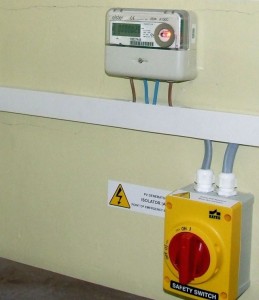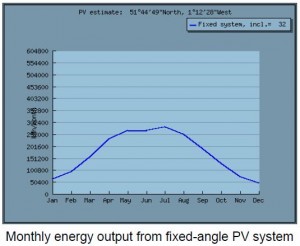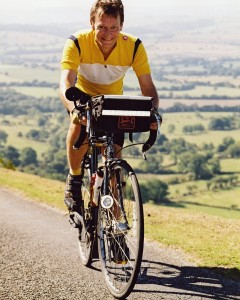We decided to investigate solar PV panels last Autumn. I’d vaguely thought about them before but my interest had been revived when I become aware of the guaranteed Feed-in Tariff (FiT) that was introduced in Spring 2010. At current installation prices solar panels would take a long, long time to pay for themselves just in saved electricity but the FiT guarantees 41.3p per kWh unit generated for the next 25 years – that’s more than 3 times what we currently pay per unit for electric – AND you get to use the electricity as well as being paid for it. Jane agreed it was worth looking into and not long after we were chatting with the rep from Solar PVE.
In for a penny in for a pound so I specified ‘as many as you can safely get up there’. The Solar PVE surveyor reckoned 14 180W panels, 7 each on our south east and south west facing roofs. I like to get on with things so we planned to get the panels installed in December, unfortunately our roof was buried in snow so this was impossible. But mid January the scaffolding went up and a week later the roofers arrived.
 First they had to install roof bars which were secured to our rafters via solid looking roof hooks that passed underneath our old, fragile and rather mossy tiles. The roofers came equipped with spare tiles to deal with any breakages, a couple of which they used. It poured with rain the Monday morning they arrived but after sitting in the van for a bit it cleared and they managed to get all the bars up Monday and the panels mounted on Tuesday.
First they had to install roof bars which were secured to our rafters via solid looking roof hooks that passed underneath our old, fragile and rather mossy tiles. The roofers came equipped with spare tiles to deal with any breakages, a couple of which they used. It poured with rain the Monday morning they arrived but after sitting in the van for a bit it cleared and they managed to get all the bars up Monday and the panels mounted on Tuesday.
 Meanwhile the electrician installed 2 1500W inverters in our attic. The panels generate around 24 volts DC per panel at quite high current, like a load of car batteries wired together. The inverters convert this to 230 volts AC which is then fed – via a generation meter, 2 safety isolators, a 16A MCB and a 30mA RCD – into our existing electrical installation. For safety the inverters are ‘grid-tied’ which means they cannot feed power into your installation unless they detect existing power from your electric supplier. So they won’t work in a power cut which is a pity but they won’t kill an electrician who isn’t expecting 230V coming the wrong way down the wire which is a good thing.
Meanwhile the electrician installed 2 1500W inverters in our attic. The panels generate around 24 volts DC per panel at quite high current, like a load of car batteries wired together. The inverters convert this to 230 volts AC which is then fed – via a generation meter, 2 safety isolators, a 16A MCB and a 30mA RCD – into our existing electrical installation. For safety the inverters are ‘grid-tied’ which means they cannot feed power into your installation unless they detect existing power from your electric supplier. So they won’t work in a power cut which is a pity but they won’t kill an electrician who isn’t expecting 230V coming the wrong way down the wire which is a good thing.
 I get back from work Wednesday to find a note saying it’s all up and running, job done apart from removing the scaffolding (which is blocking in our wheelie bins so we’ll be glad to see the back of). I don’t like heights, when I was a lot younger I did a bit of roofing and don’t remember being scared, but somewhere along the line I’ve gone the other side of cautious. Still I doubt I’ll ever get a chance to have close look at the panels again so up I go with the camera. They don’t look like they’ll be falling off in a hurry!
I get back from work Wednesday to find a note saying it’s all up and running, job done apart from removing the scaffolding (which is blocking in our wheelie bins so we’ll be glad to see the back of). I don’t like heights, when I was a lot younger I did a bit of roofing and don’t remember being scared, but somewhere along the line I’ve gone the other side of cautious. Still I doubt I’ll ever get a chance to have close look at the panels again so up I go with the camera. They don’t look like they’ll be falling off in a hurry!
 All that remains, apart from a bit of tidying that I say I’ll do as Jane has had enough builders for the moment, is to claim our tariff. It is a requirement that both the panels and the installers are MCS certified, the certificates for both are emailed to me on Friday so I download the form from Southern Electric’s website and put our application in straight away. If I understand correctly it’s now just a matter of us giving them a quarterly reading and them giving us a quarterly cheque. The FiT is not government money, it is paid by the electricity supplier who will no doubt pass the cost on to the majority who are indirectly polluting by purchasing power generated by non-renewables – sneaky eh!
All that remains, apart from a bit of tidying that I say I’ll do as Jane has had enough builders for the moment, is to claim our tariff. It is a requirement that both the panels and the installers are MCS certified, the certificates for both are emailed to me on Friday so I download the form from Southern Electric’s website and put our application in straight away. If I understand correctly it’s now just a matter of us giving them a quarterly reading and them giving us a quarterly cheque. The FiT is not government money, it is paid by the electricity supplier who will no doubt pass the cost on to the majority who are indirectly polluting by purchasing power generated by non-renewables – sneaky eh!
The Numbers
The area adjusted SAP (Standard Assessment Procedure) figures we’ve been given by Solar PVE estimate we will produce 2147 kWh units per annum for which we would get, tax free and index linked, £837 FiT + £32 for electric exported + £107 saving on our bill. From this they estimate the installation will pay back the £11,750 inc it cost in 11 years. It is guaranteed for 10 years with output from the panels guaranteed for 25 years and a predicted useful life of 40 years. It’s also supposed to reduce our CO2 footprint by 1.2 tons a year.
 Now I’m not a total fool – I bought an endowment once and that woke me up to the ability of salesmen to lie through their teeth without the authorities protecting Joe Public. So taking a look at figures from elsewhere I find that the figures from PVGIS predict a similar output, 2060 kWh per year and also that they predict an output almost 5 times higher in the summer meaning the average 2kWh per day so far in January is about on target.
Now I’m not a total fool – I bought an endowment once and that woke me up to the ability of salesmen to lie through their teeth without the authorities protecting Joe Public. So taking a look at figures from elsewhere I find that the figures from PVGIS predict a similar output, 2060 kWh per year and also that they predict an output almost 5 times higher in the summer meaning the average 2kWh per day so far in January is about on target.



